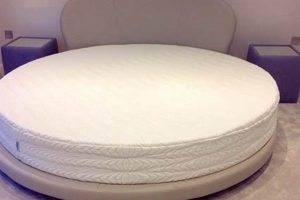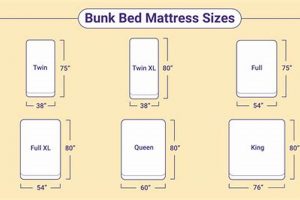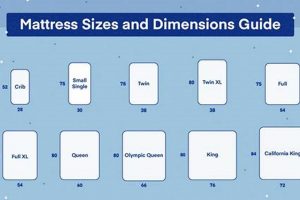The integration of technology into sleep surfaces represents a significant advancement in bedding. These advanced sleep systems incorporate materials and features designed to optimize comfort, support, and temperature regulation, often utilizing sensors and data analysis for personalized sleep experiences. As an example, some models employ adjustable air chambers controlled by smartphone apps to tailor firmness levels.
The rise of technologically advanced sleep systems addresses the increasing awareness of sleep’s impact on overall health and well-being. Benefits include enhanced pressure relief, improved spinal alignment, and potential mitigation of sleep disturbances. Historically, bedding focused primarily on basic comfort; however, contemporary designs prioritize optimizing the sleep environment through technological innovations that offer quantifiable results.
The following sections will delve into specific technological aspects integrated into modern sleep surfaces, discussing innovations in materials, sensor technology, and personalization features that contribute to a more restful and restorative sleep experience.
Considerations for Technologically Advanced Sleep Surfaces
Selecting a technologically advanced sleep surface requires careful consideration of individual needs and technological specifications. A thoughtful approach ensures optimal alignment of product features with personal sleep preferences and requirements.
Tip 1: Evaluate Sensor Integration. Sensor capabilities within the sleep surface should be scrutinized. Determine the type of data collected (e.g., sleep stages, heart rate) and how this data is utilized to enhance sleep quality, such as adjusting firmness or temperature.
Tip 2: Assess Material Composition. Prioritize materials known for breathability and temperature regulation. Technologies such as phase-change materials can mitigate overheating, contributing to a more consistent sleep temperature.
Tip 3: Investigate Adjustability Options. Electrically adjustable models offer personalized comfort through customizable zones. Ensure the adjustment mechanisms are reliable and intuitive to operate.
Tip 4: Review Connectivity Features. If the system incorporates connectivity to smartphones or other devices, evaluate the security protocols and data privacy policies to safeguard personal information.
Tip 5: Scrutinize Warranty Terms. A comprehensive warranty is crucial for technologically advanced sleep surfaces. Pay close attention to coverage duration and specific conditions that may void the warranty.
Tip 6: Examine Motion Isolation Properties. For co-sleepers, motion isolation technology minimizes disturbance from partner movement, promoting uninterrupted sleep cycles.
Tip 7: Research the Manufacturer’s Reputation. Opt for established manufacturers with positive customer reviews and a demonstrated commitment to product quality and customer support.
Careful adherence to these recommendations facilitates the selection of a technologically advanced sleep surface that aligns with individual needs, ultimately promoting enhanced sleep quality and improved well-being.
The following sections will explore the ongoing innovations and future directions within the realm of technologically enhanced sleep solutions.
1. Sensor Integration
Sensor integration within technologically advanced sleep surfaces represents a fundamental component of the overall system functionality. The embedded sensors serve as the primary data acquisition mechanism, collecting physiological metrics and environmental parameters relevant to the sleep experience. This data stream initiates a chain of cause and effect, wherein collected information triggers automated adjustments or provides insights for user-initiated modifications to the sleep environment. For instance, pressure sensors can detect areas of concentrated pressure, prompting an adjustment in air chamber inflation to redistribute weight and improve spinal alignment. Temperature sensors can similarly detect temperature fluctuations, signaling the activation of cooling or warming mechanisms within the mattress. The significance of sensor integration lies in its ability to move beyond subjective comfort towards objective, data-driven optimization of sleep conditions. Examples include mattresses that track sleep stages (light, deep, REM) and use this data to provide personalized sleep reports or to subtly adjust firmness throughout the night to promote deeper sleep.
Further analysis of sensor integration reveals practical applications across diverse user needs. Athletes can leverage detailed sleep data to optimize recovery periods. Individuals with chronic pain conditions can use pressure mapping data to identify and alleviate pressure points, potentially reducing discomfort and improving sleep quality. Moreover, the data collected by these sensors can be integrated with other health and wellness platforms, providing a holistic view of an individual’s overall health. Real-world examples include mattresses used in sleep studies to gather comprehensive data on sleep patterns, contributing to a better understanding of sleep disorders and the development of more effective treatments. Sensor integration also facilitates the creation of smart homes, where sleep surfaces can communicate with other devices to optimize the entire sleep environment, such as adjusting lighting or temperature based on sleep stage.
In summary, sensor integration transforms a conventional sleep surface into a dynamic, responsive system capable of actively influencing the sleep experience. The key insights center on the capability of these sensors to gather objective data, enabling personalized adjustments and informed decision-making regarding sleep habits. Challenges exist in ensuring data privacy and security, as well as in developing algorithms that accurately interpret the complex data streams generated by these sensors. However, the ongoing advancements in sensor technology and data analytics suggest a continued evolution towards even more sophisticated and personalized sleep solutions.
2. Material Innovation
Material innovation is a core driver in the evolution of technologically enhanced sleep surfaces. The selection and engineering of materials directly influence factors such as temperature regulation, pressure relief, motion isolation, and overall durability. The cause and effect relationship is clear: advanced materials lead to improved sleep quality through enhanced comfort and support. For example, the incorporation of phase-change materials into mattress covers mitigates temperature fluctuations, resulting in a more consistent sleep environment. The importance of material selection cannot be overstated; it determines the efficacy of other technological features, such as sensor integration or adjustable support systems. Real-world examples include the use of open-cell memo
ry foam to improve airflow and reduce heat retention, addressing a common complaint associated with traditional memory foam mattresses. The practical significance lies in providing consumers with sleep solutions tailored to their specific needs and preferences, promoting better rest and overall well-being.
Further analysis reveals diverse applications of material innovation within technologically advanced sleep products. Manufacturers are increasingly utilizing materials with antimicrobial properties to inhibit the growth of bacteria and allergens, contributing to a healthier sleep environment. Graphite-infused foams enhance heat dissipation, while specialized fabrics minimize friction and promote breathability. The integration of these materials extends to adjustable air chamber systems, where durable and flexible polymers are used to ensure reliable performance and longevity. The practical applications are evident in mattresses designed for athletes, incorporating materials that promote muscle recovery, and in models for individuals with allergies, utilizing hypoallergenic materials to minimize allergic reactions. The ongoing research into new materials and their application in sleep surfaces underscores the commitment to improving sleep quality through technological advancement.
In summary, material innovation is a vital component of technologically enhanced sleep surfaces, influencing performance characteristics that directly impact sleep quality. The key insight lies in understanding that material selection is not merely an aesthetic consideration but a functional imperative. Challenges remain in balancing cost, durability, and environmental impact, driving ongoing research and development in sustainable and high-performance materials. The broader theme of technological advancement in bedding is intrinsically linked to material science, shaping the future of sleep solutions and contributing to improved health outcomes.
3. Adjustable Support
Adjustable support is a pivotal feature within technologically advanced sleep surfaces, significantly impacting user comfort and spinal alignment. Its integration represents a departure from static support systems, enabling personalized configuration of firmness levels across different mattress zones.
- Zonal Customization
Adjustable support facilitates independent modification of firmness in distinct mattress regions. Lumbar support can be increased for individuals with lower back pain, while shoulder regions can be softened to accommodate side sleepers. This targeted approach contrasts with uniform firmness mattresses, offering a more tailored ergonomic solution.
- Air Chamber Technology
Air chamber systems exemplify adjustable support mechanisms. These systems utilize inflatable chambers, controlled electronically or manually, to vary the internal pressure and, consequently, the firmness. The precise control enables users to fine-tune the sleep surface to their individual preferences and evolving needs.
- Dynamic Pressure Mapping
Advanced adjustable support systems incorporate pressure sensors to map pressure distribution across the sleep surface. This data informs automated adjustments to the support levels, optimizing pressure relief and minimizing the risk of pressure sores, particularly relevant for individuals with limited mobility.
- Long-term Adaptability
Adjustable support systems accommodate changes in body weight, sleep position, or underlying health conditions. This adaptability extends the lifespan of the sleep surface, as it can be recalibrated to meet changing user requirements, unlike static mattresses that may become unsuitable over time.
The integration of adjustable support into technologically advanced sleep surfaces demonstrates a shift towards personalized sleep solutions. These systems not only enhance immediate comfort but also provide long-term adaptability, making them a valuable asset for individuals seeking optimal spinal alignment and pressure relief.
4. Data Analytics
Data analytics represents a crucial component within technologically advanced sleep surfaces, enabling a quantifiable understanding of sleep patterns and environmental factors influencing rest quality. The integration of sensors to gather sleep-related data necessitates robust analytical processes to transform raw measurements into actionable insights. The cause and effect relationship is such that sensor data, when analyzed, enables the bed to make adjustments to environmental settings or generate recommendations for improved sleep hygiene. Data analytics’ importance lies in its capacity to personalize the sleep experience, moving beyond generalized comfort to tailored optimization. For example, tracking sleep stages (REM, deep, light) and correlating them with environmental conditions (temperature, humidity) allows for the identification of factors disrupting sleep cycles. Real-life instances include sleep studies where data analytics uncovers patterns indicative of sleep disorders, leading to more accurate diagnoses and effective treatment strategies. The practical significance lies in the potential to enhance sleep quality, promoting overall health and well-being, rather than solely providing a comfortable surface.
Further analysis reveals varied applications of data analytics in sleep technology. Manufacturers use aggregated, anonymized data to improve product designs and refine algorithms for automatic adjustments. Clinicians leverage detailed sleep reports generated by these systems to monitor patient progress and personalize treatment plans. Moreover, the integration of data analytics extends beyond individual sleep surfaces, contributing to broader research efforts aimed at understanding population-level sleep patterns and identifying risk factors for sleep-related disorders. Practical applications include the development of smart home systems that automatically optimize sleep environments based on data collected from the sleep surface and other sensors within the home. Another use case involves the integration of sleep data with wearable devices and other health monitoring platforms, providing a comprehensive view of an individual’s health status.
In summary, data analytics is integral to the functionality of technologically advanced sleep surfaces, transforming them from passive components to active participants in promoting sleep health. The key insight is recognizing that data collection, without sophisticated analytical processes, provides limited value. Challenges include ensuring data privacy and security, as well as developing algorithms that accurately interpret complex sleep data. The broader theme centers on harnessing technological advancements to gain a deeper understanding of sleep and develop personalized interventions to optimize rest and improve overall health outcomes.
5. Connectivity
Connectivity, in the context of technologically advanced sleep surfaces, refers to the capacity of the mattress to interface with external devices and networks. The cause-and-effect relationship is such that the sensors and data generated within the sleep surface are then communicated, analyzed, and acted upon through this connectivity. C
onnectivity’s importance lies in enabling remote control, data sharing, and integration with other smart home devices, elevating the mattress from a standalone product to a component of a larger connected ecosystem. For example, a mattress may connect to a smartphone app, allowing users to adjust firmness levels, track sleep patterns, and receive personalized recommendations for improved sleep. Real-life examples include sleep surfaces that communicate with smart thermostats to automatically adjust room temperature based on sleep stage or that integrate with lighting systems to create a more conducive sleep environment. The practical significance resides in enhancing user convenience, providing data-driven insights, and optimizing sleep conditions through seamless integration with other technologies.
Further analysis reveals diverse applications of connectivity within sleep technology. Cloud-based connectivity facilitates remote monitoring and diagnostics, enabling manufacturers to provide proactive customer support and troubleshoot technical issues. API integration allows third-party developers to create custom applications and integrations, expanding the functionality of the sleep surface beyond its core features. Moreover, connectivity enables the collection and analysis of aggregated, anonymized data, contributing to broader research efforts aimed at understanding sleep patterns and identifying potential health risks. Practical applications include the use of connected sleep surfaces in telemedicine, allowing healthcare providers to remotely monitor patients with sleep disorders, and in senior living facilities, where connectivity can facilitate early detection of health issues and provide personalized care. Another potential use is in hotels that may want to track their customer satisfaction.
In summary, connectivity is an integral component of technologically advanced sleep surfaces, facilitating data exchange, remote control, and integration with other devices. The key insight is that connectivity enables the transformation of a traditional mattress into a smart, data-driven device capable of actively participating in improving sleep quality. Challenges exist in ensuring data security and privacy, as well as in developing interoperable standards to facilitate seamless integration with other devices and platforms. The broader theme focuses on the increasing integration of technology into all aspects of daily life, including sleep, and the potential benefits and challenges associated with this trend.
6. Sleep Tracking
The integration of sleep tracking technology into technologically advanced sleep surfaces represents a convergence of health monitoring and personalized comfort. This pairing facilitates the collection of sleep data directly from the user’s sleep environment, enabling a more comprehensive understanding of individual sleep patterns and potential disruptions.
- Sensor-Driven Data Acquisition
Sleep tracking within these sleep systems relies on embedded sensors to capture physiological data, including heart rate, respiration rate, movement patterns, and sleep stages. The data is then transmitted to a processing unit for analysis, providing a detailed account of sleep duration, efficiency, and quality. A practical example involves the use of pressure sensors to detect restlessness and correlate it with specific sleep stages, potentially revealing underlying sleep disturbances.
- Environmental Parameter Monitoring
Beyond physiological metrics, sleep tracking systems also monitor environmental factors such as temperature, humidity, and ambient light levels. Correlating these parameters with sleep data allows for the identification of external factors that may be influencing sleep quality. For example, fluctuations in room temperature during the night can be linked to awakenings or changes in sleep stage distribution, informing adjustments to the sleep environment.
- Personalized Sleep Reports and Insights
The data collected and analyzed by sleep tracking systems is typically presented to the user in the form of personalized sleep reports. These reports provide insights into sleep patterns, highlight potential areas for improvement, and offer recommendations for optimizing sleep hygiene. For instance, a sleep report may indicate a prolonged period of light sleep, suggesting the need for adjustments to bedtime routines or sleep environment to promote deeper sleep.
- Integration with Health and Wellness Platforms
Many technologically advanced sleep surfaces with sleep tracking capabilities offer integration with other health and wellness platforms. This integration allows users to combine sleep data with other health metrics, such as activity levels, dietary information, and stress levels, providing a more holistic view of their overall health. For instance, sleep data can be integrated with fitness trackers to assess the impact of exercise on sleep quality, informing adjustments to training schedules and recovery strategies.
The integration of sleep tracking into technologically advanced sleep surfaces provides a valuable tool for understanding and optimizing sleep. The data-driven insights generated by these systems empower users to make informed decisions about their sleep habits and environment, potentially leading to improved sleep quality and overall well-being. The effectiveness of these systems hinges on the accuracy of the sensors, the sophistication of the data analysis algorithms, and the actionable nature of the insights provided to the user.
7. Firmness Customization
Firmness customization represents a core value proposition within the realm of technologically advanced sleep surfaces. The capability to independently adjust the support level provided by a mattress has evolved from a niche feature to an expectation among consumers seeking personalized sleep solutions. The cause-and-effect relationship is evident: individualized firmness settings can optimize spinal alignment, pressure relief, and overall comfort, leading to improved sleep quality. The importance of this lies in the recognition that sleep preferences and biomechanical needs vary significantly among individuals, rendering static firmness levels inadequate for many. A notable example involves electronically adjustable air chamber mattresses, where users can independently control the firmness of each side of the bed, accommodating differing preferences of co-sleepers. This level of personalization has practical significance for individuals with chronic pain, spinal conditions, or varying body weights, enabling them to fine-tune the sleep surface to their specific requirements.
Further analysis reveals diverse implementation strategies for firmness customization within technologically enhanced sleep solutions. Some systems employ adjustable air chambers, while others utilize modular foam layers that can be rearranged or replaced to alter the overall firmness profile. Pressure mapping technology, integrated into certain models, provides real-time feedback on pressure distribution, guiding users in optimizing their firmness settings. A practical application involves athletes utilizing adjustable firmness mattresses to facilitate muscle recovery and promote blood circulation. The ability to modify support levels can also be beneficial for individuals recovering from injuries or surgeries, allowing them to adapt the sleep surface to their changing
needs. The trend towards firmness customization reflects a broader movement towards personalized healthcare and consumer empowerment.
In summary, firmness customization is a significant differentiator within the technologically advanced sleep surface market, addressing the inherent variability in individual sleep preferences and biomechanical requirements. The key insight lies in understanding that personalized support is not merely a luxury but a functional necessity for many consumers. Challenges remain in ensuring the durability and reliability of adjustable mechanisms, as well as in providing clear and intuitive user interfaces for controlling firmness settings. The broader theme of personalized sleep solutions is poised to continue to grow in prominence, driven by increasing consumer awareness of the importance of sleep and ongoing advancements in material science and sensor technology.
Frequently Asked Questions about “bed tech mattress”
This section addresses common inquiries regarding technologically advanced sleep surfaces, often referred to by the keyword “bed tech mattress.” The information provided aims to clarify aspects of functionality, benefits, and considerations for prospective purchasers.
Question 1: What distinguishes a “bed tech mattress” from a conventional mattress?
“Bed tech mattress” models incorporate technology such as sensor integration, adjustable support systems, and advanced materials not typically found in traditional mattresses. These features aim to provide personalized comfort and data-driven insights into sleep patterns.
Question 2: Is there scientific evidence supporting the claims associated with “bed tech mattress” benefits?
While some studies suggest potential benefits such as improved sleep quality and pressure relief, rigorous, peer-reviewed research is ongoing. Individual experiences may vary, and claims should be evaluated critically.
Question 3: What are the primary technological components found in a “bed tech mattress”?
Common technological components include pressure sensors, temperature sensors, adjustable air chambers, and connectivity modules for data transmission and remote control. The specific components vary depending on the model and manufacturer.
Question 4: How does data privacy factor into the use of a “bed tech mattress” with sensor integration?
Data privacy is a significant concern. Consumers should carefully review the manufacturer’s data privacy policies to understand how personal information is collected, stored, and used. Encryption and data anonymization practices are crucial considerations.
Question 5: What is the typical lifespan of a “bed tech mattress” compared to a traditional mattress?
The lifespan of a “bed tech mattress” can vary depending on the quality of materials and the complexity of the integrated technology. While some models may offer enhanced durability, the electronic components could be subject to failure, potentially shortening the overall lifespan compared to simpler mattresses.
Question 6: What factors should be considered when selecting a “bed tech mattress”?
Factors to consider include sensor accuracy, material breathability, adjustability range, data privacy policies, warranty coverage, and the reputation of the manufacturer. A thorough evaluation of individual needs and preferences is essential.
In summary, “bed tech mattress” options offer potential benefits through technological integration. However, informed decisions require a careful assessment of scientific evidence, data privacy implications, and individual needs.
The following sections will explore ongoing innovations and future directions within the realm of technologically enhanced sleep solutions.
Conclusion
The preceding sections have explored the multifaceted nature of “bed tech mattress” solutions. The integration of sensors, adjustable support mechanisms, advanced materials, and data analytics signifies a paradigm shift in sleep surface design. Enhanced personalization, data-driven insights, and potential improvements in sleep quality characterize this technological evolution.
Despite the advancements, critical evaluation remains paramount. Long-term reliability, data security, and the validity of manufacturer claims warrant careful consideration. The future trajectory of “bed tech mattress” development will likely involve further refinement of sensor technology, enhanced data analytics capabilities, and increased integration with broader health and wellness ecosystems. Continued research and transparent reporting are essential to substantiate claims and ensure consumer confidence in this evolving market segment.


![Best Split Mattress Beds: Reviews & Guide [Year] Organic & Natural Mattress Buyer’s Guide: Non-Toxic Sleep Solutions Best Split Mattress Beds: Reviews & Guide [Year] | Organic & Natural Mattress Buyer’s Guide: Non-Toxic Sleep Solutions](https://mattressworldpa.com/wp-content/uploads/2025/07/th-7152-300x200.jpg)
![[Protect Bed!] Bed Bath & Beyond Mattress Covers - Deals Organic & Natural Mattress Buyer’s Guide: Non-Toxic Sleep Solutions [Protect Bed!] Bed Bath & Beyond Mattress Covers - Deals | Organic & Natural Mattress Buyer’s Guide: Non-Toxic Sleep Solutions](https://mattressworldpa.com/wp-content/uploads/2025/07/th-7151-300x200.jpg)



